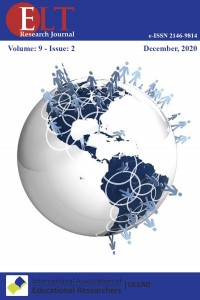Abstract
References
- Bayyurt, Y. (2012). Foreign language education within 4+4+4 education system. 1st Foreign Language Education Workshop. Hacettepe University, Ankara
- Carless, D. (2006). Good practices in team teaching in Japan, South Korea and Hong Kong. System, 34, 341-351.
- Carroll, T. G., & Foster, E. (2008). Learning teams: Creating what’s next. Retrieved from https://files.eric.ed.gov/fulltext/ED505910.pdf.
- Çeti̇ntaş, B.G. & Yazici, Z. (2016). Teachers’ opinions concerning bilingual education in early childhood: practice and experience in pre-school and nursery classes. Mediterranean Journal of Humanities, 173-187.
- Dillon, A. (2015). Bilingual co-teaching in the UAE to enhance speaking skills. In Paper presented at the conference of issues of multilingualism in early childhood Education: Zero to six, Rome, Italy.
- Dove, M., & Honigsfeld, A. (2010). ESL coteaching and collaboration: Opportunities to develop teacher leadership and enhance student learning. TESOL Journal, 1, 3–22.
- Friend, M. (2008). Co-teaching: A simple solution that isn't that simple after all. Journal of Curriculum and Instruction, 2(2), 9-19.
- Genesee, F. & K. Lindholm-Leary. 2013. Two case studies of content-based language education. Journal of Immersion and Content- Based Education, 1, 3–33.
- Gibbs, G.R. (2007). Analysing qualitative data. London: SAGE Publications.
- Main, K. (2007). A year- long study of the formation and development of middle school teaching teams. Unpublished Doctoral dissertation. Griffith University.
- Mifsud, C. L. and Ann Vella, L. (2018). To mix languages or not? Preschool bilingual education in Malta. In M. Schwartz (ed), Preschool bilingual education: Agency in interactions between children, teachers, and parents (pp.57-98). Switzerland: Springer
- Prošić- Santovac, D. and Radovič, D. (2018). Separating the languages in a bilingual preschool: To do or not to do? In M. Schwartz (ed), Preschool bilingual education: Agency in interactions between children, teachers, and parents (pp.27-56). Switzerland: Springer
- Schwarz, M. and Gorgatt, N. (2018). Fortunately, I found a home here that allows me personal expression”: Co-teaching in the bilingual Hebrew-Arabic-speaking preschool in Israel. Teaching and Teacher Education, 71, 46-56.
- Sileo, J. M. (2011). Co-teaching: Getting to know your partner. Teaching Exceptional Children, 43(5), 32-38.
- Vangrieken, K., Dochy, F., Raes, E., & Kyndt, E. (2015). Teacher collaboration: A systematic review. Educational Research Review, 15, 17–40.
- Villa, R. A., Thousand, J. S., & Nevin, A. I. (2008). A guide to co- teaching: Practical tips for facilitating student learning (2nd ed.). Thousand Oaks, CA: Corwin.
Abstract
This study examines the effects of co-teaching model on teachers in a private nursery in Turkey. The data were collected in a private nursery in the city of Siirt. The participants were English language teachers and preschool teachers in the nursery in which a bilingual language model is implemented. The study is qualitative and uses semi- structured interviews and participant observation as data collection methods. Different teaching models are used in bilingual nurseries. Co-teaching is one of them and recently used in different contexts. But it seems that there is a limited research into it. The findings show that co-teaching enhance teachers’ professional development and teaming skills. The findings also indicate that co-teaching enables teachers to improve their teaching skills and creates advantages for teachers. The study suggests that pre-service English language teachers need to have training in teaching young children.
References
- Bayyurt, Y. (2012). Foreign language education within 4+4+4 education system. 1st Foreign Language Education Workshop. Hacettepe University, Ankara
- Carless, D. (2006). Good practices in team teaching in Japan, South Korea and Hong Kong. System, 34, 341-351.
- Carroll, T. G., & Foster, E. (2008). Learning teams: Creating what’s next. Retrieved from https://files.eric.ed.gov/fulltext/ED505910.pdf.
- Çeti̇ntaş, B.G. & Yazici, Z. (2016). Teachers’ opinions concerning bilingual education in early childhood: practice and experience in pre-school and nursery classes. Mediterranean Journal of Humanities, 173-187.
- Dillon, A. (2015). Bilingual co-teaching in the UAE to enhance speaking skills. In Paper presented at the conference of issues of multilingualism in early childhood Education: Zero to six, Rome, Italy.
- Dove, M., & Honigsfeld, A. (2010). ESL coteaching and collaboration: Opportunities to develop teacher leadership and enhance student learning. TESOL Journal, 1, 3–22.
- Friend, M. (2008). Co-teaching: A simple solution that isn't that simple after all. Journal of Curriculum and Instruction, 2(2), 9-19.
- Genesee, F. & K. Lindholm-Leary. 2013. Two case studies of content-based language education. Journal of Immersion and Content- Based Education, 1, 3–33.
- Gibbs, G.R. (2007). Analysing qualitative data. London: SAGE Publications.
- Main, K. (2007). A year- long study of the formation and development of middle school teaching teams. Unpublished Doctoral dissertation. Griffith University.
- Mifsud, C. L. and Ann Vella, L. (2018). To mix languages or not? Preschool bilingual education in Malta. In M. Schwartz (ed), Preschool bilingual education: Agency in interactions between children, teachers, and parents (pp.57-98). Switzerland: Springer
- Prošić- Santovac, D. and Radovič, D. (2018). Separating the languages in a bilingual preschool: To do or not to do? In M. Schwartz (ed), Preschool bilingual education: Agency in interactions between children, teachers, and parents (pp.27-56). Switzerland: Springer
- Schwarz, M. and Gorgatt, N. (2018). Fortunately, I found a home here that allows me personal expression”: Co-teaching in the bilingual Hebrew-Arabic-speaking preschool in Israel. Teaching and Teacher Education, 71, 46-56.
- Sileo, J. M. (2011). Co-teaching: Getting to know your partner. Teaching Exceptional Children, 43(5), 32-38.
- Vangrieken, K., Dochy, F., Raes, E., & Kyndt, E. (2015). Teacher collaboration: A systematic review. Educational Research Review, 15, 17–40.
- Villa, R. A., Thousand, J. S., & Nevin, A. I. (2008). A guide to co- teaching: Practical tips for facilitating student learning (2nd ed.). Thousand Oaks, CA: Corwin.
Details
| Primary Language | English |
|---|---|
| Subjects | Language Studies |
| Journal Section | Research Article |
| Authors | |
| Publication Date | December 31, 2020 |
| Submission Date | November 20, 2020 |
| Published in Issue | Year 2020 Volume: 9 Issue: 2 |


